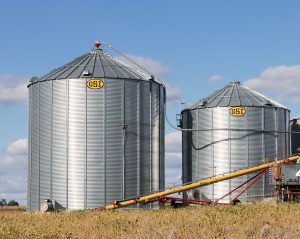 Print a Sign-In Sheet | Spanish Version Coming Soon
Print a Sign-In Sheet | Spanish Version Coming Soon
Engulfment and Suffocation Hazards
Grain storage bin entry is very dangerous and exposes workers to serious suffocation hazards – a leading cause of fatalities in this industry. Suffocation can occur when workers are engulfed (buried or covered) by grain or when bins develop hazardous atmospheres or a lack of oxygen.
Engulfment can occur when a worker:
- Stands on moving/flowing grain – the moving grain acts like “quicksand” and buries the worker in seconds.
- Stands on or below a “bridging” condition – “bridging” occurs when grain clumps together, because of moisture or mold, creating an empty space beneath the grain as it is unloaded. If a worker stands on or below the “bridged” grain, it can collapse unexpectedly and bury the worker.
- Stands next to an accumulated pile of grain on the side of the bin – the grain pile can collapse onto the worker unexpectedly or when the worker attempts to dislodge it.
The grain’s behavior and weight make it extremely difficult for a worker to get out of the grain without assistance. Tragically, incidents in grain bins often result in multiple fatalities because co-workers attempt rescue and fall victim as well. These fatalities are preventable if employers follow work practices and provide training and equipment as required by the Occupational Safety and Health Administration’s (OSHA) Inspection of Grain Handling Facilities Standard, 29 CFR 1910.272.
Where workers enter storage bins, employers must:
- De-energize (turn off) and disconnect, lockout and tag, or block off all mechanical, electrical, hydraulic, and pneumatic equipment that presents a danger, particularly grain-moving equipment. Grain must not be emptied or moved into or out of the bin while workers are inside because it creates a suction that can pull the worker into the grain in seconds.
- Prohibit walking down grain and similar practices where a worker walks on grain to make it flow.
- Prohibit entry onto or below a bridging condition or where grain is built up on the side of the bin.
- Provide a body harness with a lifeline or boatswain’s chair to each worker entering a bin from a level at or above stored grain, or when a worker will walk or stand on stored grain with a body harness. Ensure the lifeline is positioned and of sufficient length to prevent a worker from sinking further than waist-deep in grain.
- Provide workers with rescue equipment, such as winch systems specifically suited for rescue from the bin.
- Station an observer equipped to provide assistance and perform rescue operations outside the bin.
- Ensure communications (visual, voice, or signal line) are maintained between the observer and the workers who enter the bin.
- Test the air within a bin for oxygen content and presence of hazardous gases before entry.
- Provide and continue ventilation until any unsafe atmospheric conditions are eliminated.
- If toxicity or oxygen deficiency cannot be eliminated, workers must wear appropriate respirators.
- Issue a permit each time a worker enters a bin unless the employer is present during the entire entry operation. The permit must certify that the above precautions have been implemented before workers enter the bin.
KEMI does not assume liability for the content of information contained herein. Safety and health remain your responsibility. This information is to be used for informational purposes only and not intended to be exhaustive or a substitute for proper training, supervision, or manufacturers’ instructions/recommendations. KEMI, by publication of this information, does not assume liability for damage or injury arising from reliance upon it. Compliance with this information is not a guarantee or warranty that you will be in conformity with any laws or regulations nor does it ensure the absolute safety of any person, place, or object, including, but not limited to, you, your occupation, employees, customers, or place of business.

